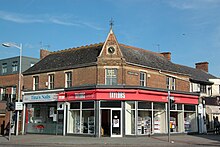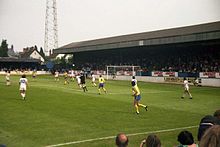Headington
| Headington | |
|---|---|
 | |
Location withinOxfordshire | |
| OS grid reference | SP5407 |
| Civil parish |
|
| District | |
| Shire county | |
| Region | |
| Country | England |
| Sovereign state | United Kingdom |
| Post town | Oxford |
| Postcode district | OX3 |
| Dialling code | 01865 |
| Police | Thames Valley |
| Fire | Oxfordshire |
| Ambulance | South Central |
| UK Parliament | |
| Website | headington.org.uk |
Headingtonis an eastern suburb ofOxford,in the county ofOxfordshire,England.[1]It is at the top ofHeadington Hilloverlooking the city in theThamesvalley below, and borderingMarstonto the north-west,Cowleyto the south, andBartonandRisinghurstto the east. The life of the large residential area is centred uponLondonRoad, the main road between London and Oxford.
History[edit]
The site of Headington shows evidence of continued occupation from theStone Age,as the 2001 fieldexcavationsinBartonLane found, suggesting a date in the 11th century BC. Pottery was found on theManor Ground,suggesting anIron Agesettlement there in the 7th century BC.Romankilns from about 300 have been found, including one now on display at theMuseum of Oxford.Anglo-Saxonburial remains from about 500 have also been discovered. Headington'stoponymis derived from theOld EnglishHedena's dun,meaning "Hedena's hill", when it was the site of a palace or hunting lodge of theKings of Mercia.In acharterof 1004,Æthelred the Unready,"written at the royal ville called Headan dune", gave land in Headington toSt Frideswide's Priory,which included the quarry and the area around it.
Henry Igranted a chapel at Headington to theAugustiniancanons regularof St Frideswide's Priory, when the priory was founded in 1122.[2]Theparish church of Saint Andrewwas built in the middle of the 12th century and enlarged in the 13th century.[2][3]Thebell towerwas started in the 13th or 14th century[3]and completed in about 1500.[2]St. Andrew's was repaired in the 17th and 18th centuries.[2]TheGothic RevivalarchitectJ.C. Bucklerrestored the building[2]and lengthened thenavein 1862–1864.[2][3]
Headington developed rapidly in the early 20th century, significant amounts of housing developing around the medieval village, now known as Old Headington, around the original parish church of St Andrew. In 1927, it became anurban districtseparate from theHeadington Rural Districtand in 1929 it was added to the city of Oxford.[4]New Headington refers to some of the area on the south side of the London Road, originating as a late 19th-century suburb.[5]Other neighbourhoods of the modern Headington suburb include Highfield, Quarry, andHeadington Hill.[6]
TheCity of Oxford Silver Bandbegan as the HeadingtonBrass Bandhaving been founded in the 19th century. In 2002 a re-warding of the City created a ward called Headington representing both sides of the London Road, from Bury Knowle Park to Headley Way, with two elected representatives. The first councillors for this ward were David Rundle (2002–2014) andStephen Tall(2002–2008). Ruth Wilkinson was elected to succeed Stephen Tall in May 2008, and Mohammed Altaf-Khan to succeed David Rundle in 2014.

In 1921 thecivil parishhad a population of 5328.[7]On 1 April 1929 the parish was abolished and merged withSt Giles and St John,Stowood,Horspath,Forest Hill with ShotoverandElsfield.[8]
Headington today[edit]
Headington has a large and growing population.[9]Headington's main employment sectors are medicine, education, and research. In the centre of Headington are a number of shops,pubs,cafés, restaurants, and other services. The area also includes the main campus ofOxford Brookes University,Ruskin College(which moved in its entirety from centralOxfordto its Headington site in 2012), and the city's main hospitals, including theJohn Radcliffe,NuffieldandChurchill.

Headington's most famous modern landmark isThe Headington Shark,made byJohn Buckleyfor local broadcasterBill Heinein 1986. Headington has a number of green spaces includingHeadington Hill Park,Bury Knowle park andSouth Park.Close by isShotover Hill,aheathand woodland area with views overOxfordshire,and listed as aSite of Special Scientific Interest.TheWarneford Meadowa wild grassland, bought in 1918 by public subscription for the adjacentWarneford Hospital,has been registered as a Town Green and has thus escaped development.
Sport and leisure[edit]

Oxford Unitedwere formed as Headington F.C. in 1893,[10]adding the suffix United in 1911 after merging with Headington Quarry. Until 2001 their home ground was theManor Ground,which had its main entrance onLondonRoad.[11]In 2001 Oxford United moved to theKassam StadiumnearBlackbird Leys.[12]The Manor Ground has since been demolished and a private hospital built on the site.[13]Headington has anon-league footballteam,Headington Amateurs,who play at theBartonRecreation Ground.
Notable residents[edit]
- Brian Aldiss,the science fiction writer, lived in Old Headington until his death in 2017.
- Joan Clarke Murray,one of the Enigma code breakers, lived at 7 Larkfields from about 1991 until her death in 1996.[14]
- Elizabeth Jennings,a renowned poet, spent her latter years living at Unity House (8 St Andrew's Lane), which was formerly the home of Emily Ann Yockney, the sister ofLord Nuffield(William Morris).
- Arthur Kerry(1879–1967), English professional footballer
- C. S. Lewis,author ofThe Chronicles of Narnia,moved to the district in 1921 (he was born inNorthern Irelandin 1898) and lived there until moving toThe Kilnsat nearbyRisinghurstin 1930. He lived there until his death in 1963.[15]Lewis is buried atHoly TrinityChurch atHeadington Quarry.
- A more recent resident wasJohn Simpson,senior editor of theOxford English Dictionary.
- J. R. R. Tolkien,author ofThe HobbitandThe Lord of the Rings,lived at 76Sandfield Roadin Headington from 1953 until 1968.
- Emma Watson,Hermione Granger from the Harry Potter films, lived in Headington. She also attendedHeadington School.
A number ofOxfordacademics have lived in Headington over the years. They includeLord Krebs,David Marquand,Anthony Kenny,SirIsaiah Berlin,the historianA. B. Emden,the chemistDalziel Hammick,Lord Elton,Michael Ernest Sadler,Cyril Bailey,his daughterMary Creighton Baileywho was born there, andJohn Johnson(the University Printer). Others included the authorElizabeth Bowen,Robert Maxwelland his daughterGhislaine Maxwell,Lord Nuffield(William Morris), andAnne Diamond,the television presenter and author.
See also[edit]
References[edit]
- ^Hibbert, Christopher,ed. (1988). "Headington".The Encyclopaedia of Oxford.Macmillan.pp. 166–167.ISBN0-333-39917-X.
- ^abcdefLobel, 1957, pages 157–168
- ^abcSherwood & Pevsner, 1974, page 336
- ^Stephanie Jenkins (7 August 2010)."Miscellaneous History: History of policing".History of Headington, Oxford.Retrieved29 June2008.
- ^Stephanie Jenkins."New Headington Village".Headington history: Streets.Retrieved27 April2021.
- ^Stephanie Jenkins."Headington Streets".Headington history: Streets.Retrieved27 April2021.
- ^"Population statistics Headington AP/CP through time".A Vision of Britain through Time.Retrieved6 April2024.
- ^"Relationships and changes Headington AP/CP through time".A Vision of Britain through Time.Retrieved6 April2024.
- ^"oxford.gov.uk"(PDF).
- ^Brodetsky, Martin; Brunt, Heather; Williams, Chris; Crabtree, David."A history of Oxford United Football Club".Oxford United F.C. Archived fromthe originalon 15 September 2007.Retrieved19 December2019.
- ^Dawkins, Andrew (21 October 2014)."What happened to England's lost football grounds?".BBC.Retrieved19 December2019.
- ^"The Kassam Stadium".The Stadium Guide.Retrieved19 December2019.
- ^"Hospital in U-turn over Nuffield title".Oxford Mail.13 May 2003.Retrieved19 December2019.
- ^Jenkins, Stephanie."Joan CLARKE, later Mrs Murray (1917–1996)".Welcome to Headington, Oxford.Retrieved19 September2017.
- ^John Visser (1994–2010)."Multimedia – Picture Album".Into the Wardrobe – a CS Lewis web site.Retrieved30 December2010.
Sources[edit]
- Bloxham, Christine; Shatford, Susanne (1996).The Changing Faces of Headington: Book One.Witney: Robert Boyd Publications.ISBN1-899536-05-1.
- Lobel, Mary D.,ed. (1957).A History of the County of Oxford: Volume 5: Bullingdon Hundred.Victoria County History.pp. 157–168.
- Sherwood, Jennifer;Pevsner, Nikolaus(1974).Oxfordshire.The Buildings of England.Harmondsworth:Penguin Books.pp. 336–339.ISBN0-14-071045-0.
External links[edit]
- Headington community website— news, local information, and an extensive history section
- Headington's City Councillors website– updates and contact details for the ward that covers the central part of Headington
- Headington Market



